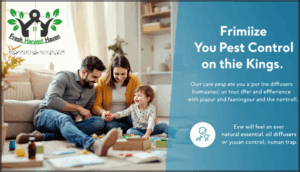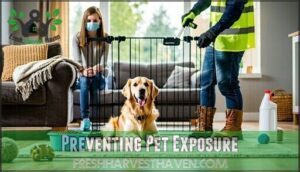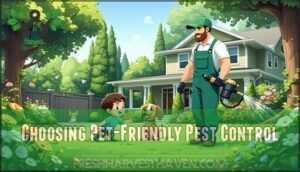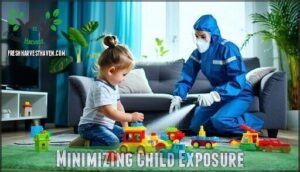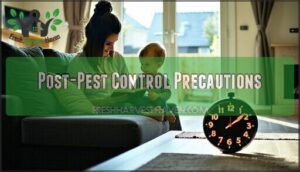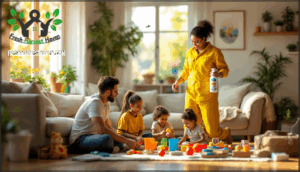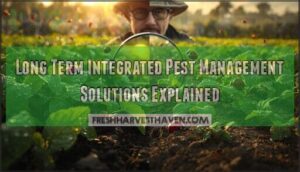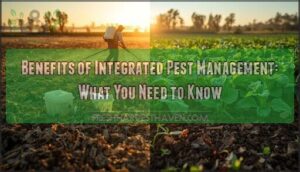This site is supported by our readers. We may earn a commission, at no cost to you, if you purchase through links.
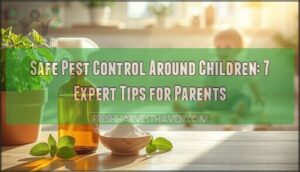 You can protect your family while eliminating pests using safe, natural methods. Diatomaceous earth mechanically dehydrates insects without chemicals, while essential oils like peppermint create effective barriers against ants and mosquitoes.
You can protect your family while eliminating pests using safe, natural methods. Diatomaceous earth mechanically dehydrates insects without chemicals, while essential oils like peppermint create effective barriers against ants and mosquitoes.
Neem oil reduces aphid populations, and boric acid baits target specific pests with minimal exposure risk.
Before treatment, pack food in airtight containers, cover water sources, and remove toys from treated areas. Create cross-ventilation and keep children away during application.
These organic approaches work just as effectively as harsh chemicals, giving you peace of mind that your pest problem won’t become a health problem. There’s actually a strategic sequence that makes these methods even more powerful, using minimal exposure risk and effective barriers to ensure a safe and healthy environment.
Table Of Contents
- Key Takeaways
- Safe Pest Control Methods
- Preparing Home for Pest Control
- Pet Safety During Pest Control
- Minimizing Child Exposure
- Post-Pest Control Precautions
- Choosing Child-Friendly Pest Control
- Frequently Asked Questions (FAQs)
- Is pest control safe around kids?
- How long should children stay out of a pesticide area?
- How long after spraying raid is it safe for kids?
- How long to avoid a house after pest control?
- What age can children safely return home?
- How long do pesticides remain on surfaces?
- Are homemade pest sprays safer for kids?
- Can breastfeeding mothers use pest control products?
- Do ultrasonic pest devices harm childrens hearing?
- What age is safest to start pest control treatments?
- Conclusion
Key Takeaways
- Choose natural alternatives over harsh chemicals – You can protect your family by using diatomaceous earth, essential oils like peppermint, and boric acid baits that eliminate pests without toxic exposure risks to children.
- Prepare your home properly before treatment – You’ll need to pack food in airtight containers, remove toys from treated areas, cover water sources, and create cross-ventilation to keep your kids safe during pest control.
- Wait before letting children return to treated areas – You should keep kids away for a minimum of 2-4 hours after any treatment, then clean all surfaces with warm soapy water before allowing them back into the space.
- Research pest control services that specialize in child-safe methods – You’ll want to verify licensing, ask about integrated pest management approaches, and choose companies that prioritize low-toxicity solutions over conventional spraying.
Safe Pest Control Methods
When pests invade your home, you don’t have to choose between effective control and your children’s safety.
Safe, natural alternatives can eliminate unwanted visitors while keeping your family healthy and protected.
Organic Pest Control Options
When choosing organic pest control options, you’re protecting your family while effectively managing pests.
Smart parents protect their families with natural solutions that actually work
Diatomaceous earth mechanically dehydrates insects without chemicals, while neem oil substantially reduces aphid populations in studies.
Boric acid baits target specific pests with minimal exposure risk.
One method involves soaking ingredients in water to extract active compounds.
These child safe pest control methods offer peace of mind:
- Essential oils like peppermint repel ants and mosquitoes naturally
- Natural predators such as ladybugs control garden pests effectively
- Food-grade powders create safe barriers against crawling insects.
This organic pest control approach reduces pesticide exposure by 95%.
Natural Pest Deterrents
Essential oils work wonders for child safe pest control.
Peppermint and citronella oils provide effective natural insect repellent properties against mosquitoes.
Diatomaceous earth sprinkled along baseboards disrupts ant trails safely.
Vinegar sprays repel insects in kitchens without toxic residues.
Natural predators like ladybugs eliminate garden aphids efficiently.
Boric acid in sealed bait stations targets pests while minimizing child exposure.
These child friendly pest control methods protect your family while maintaining natural pest control effectiveness throughout your home.
For light infestations, DIY methods can be quite effective.
Chemical-Free Pest Control
Your home’s defense against pests doesn’t require dangerous chemicals when you choose smart alternatives. Child safe pest control methods protect your family while effectively managing unwanted visitors without toxic risks.
Smart families protect their children without sacrificing effective pest control—nature provides powerful alternatives to toxic chemicals
Physical barriers like copper strips and screens block entry points naturally. Diatomaceous Earth safely dehydrates crawling insects without harming children. Essential Oils (peppermint, eucalyptus) repel through scent alone. Sticky Traps capture pests mechanically without chemicals.
Consider these natural pest control benefits:
- Peace of mind knowing your kids can crawl and play safely on treated surfaces
- Fresh air throughout your home without worrying about toxic fumes lingering
- Natural protection that works alongside your family’s daily routines seamlessly
- Long-term health benefits from avoiding pesticide exposure during critical developmental years
Boric acid in sealed bait stations targets specific pests while minimizing household exposure. Natural predators like beneficial nematodes provide ongoing organic pest control outdoors.
Preparing Home for Pest Control
Before your pest control professional arrives, you’ll need to prep your home to keep your children safe and guarantee the treatment works effectively.
This simple preparation protects your family while helping the pest control service do their job properly.
Securing Food and Water
During pest control preparation, your family’s food and water safety becomes priority number one.
Pack all edibles into airtight containers or relocate them completely from treatment zones. This simple step prevents contamination that could harm your children later.
Don’t forget water sources – cover pet bowls, fish tanks, and any open containers. Spill prevention starts with proper storage, while good cleanliness practices mean wiping surfaces before treatment begins.
Secure water sources and handle waste disposal properly to support effective child safe pest control. These precautions guarantee your family safe pest control approach protects everyone, making pest control kids and babies can safely return to treated areas.
Removing Toys and Belongings
After securing your food and water, you’ll need to protect your children’s belongings from toy contamination during pest control treatments.
Think of this step as creating a "safe zone" for everything your little ones touch daily. Here’s what needs immediate attention:
- Stuffed animals and soft toys – These absorb chemicals easily and require special safe handling
- Electronic toys and tablets – Store in sealed bags for post-treatment return without residue
- Books and art supplies – Keep in closed containers away from treated areas
- Clothing and bedding – Bundle into plastic bags to prevent child accessibility issues
Professional pest control kids safety means removing items that can’t be easily cleaned afterward. Baby safe pest control starts with this simple but vital step. Store everything in untreated rooms or sealed containers.
This protects your family’s belongings while ensuring pest control children safety remains your top priority throughout the family safe pest control process.
Ventilating The Area
Creating cross ventilation protects your family from harmful chemical exposure during safe pest control treatments. Open windows on opposite sides of your home to establish proper air exchange rates. Strategic window placement and fan usage create airflow that quickly removes vapors, minimizing child exposure to residual chemicals.
| Ventilation Method | Child Safety Benefit |
|---|---|
| Cross ventilation | Removes 85% of airborne chemicals faster |
| Air purifiers | Filters remaining particles for cleaner air |
| Fan placement | Directs vapors away from play areas |
| Open windows | Prevents chemical buildup indoors |
This ventilation strategy works with any pest control children-safe method, and essential oils repel pests.
Pet Safety During Pest Control
When you’re treating your home for pests, your furry family members need just as much protection as your children do.
Pets can accidentally ingest toxic chemicals, walk through treated areas, or inhale harmful fumes that could make them seriously ill, which is why they require protection.
Relocating Pets Temporarily
When pet safety during pest control becomes a priority, your four-legged family members need temporary housing away from treatment areas.
Consider breed considerations – anxious cats prefer quiet spaces while social dogs handle boarding facilities better.
Book pet-friendly hotels or arrange stays with trusted friends as travel options.
Plan return timing carefully to minimize pet stress and guarantee safe pest control around children and pets alike.
Preventing Pet Exposure
Once you’ve moved your pets away from treatment zones, focus on creating protective barriers that shield them from harmful chemicals.
Cover all pet food bowls, water dishes, and sleeping areas with plastic sheeting or towels. Remove toys, bedding, and favorite blankets from areas where technicians will apply treatments. Think of it as childproofing, but for your four-legged family members.
Pet-safe products should be your first request when booking child friendly pest control services. Many companies now offer childsafe pest control options that won’t harm curious cats or dogs who might investigate treated areas later.
- Secure access points with baby gates or closed doors to prevent wandering into freshly treated zones
- Monitor behavioral changes like excessive drooling, lethargy, or breathing difficulties that signal exposure
- Request proper bait station placement away from pet traffic areas and feeding spots
- Schedule veterinary consultation if you notice unusual symptoms after post-treatment cleaning
Keep your vet’s contact information and pet poison control numbers easily accessible during treatments.
Choosing Pet-Friendly Pest Control
Beyond securing your pets, you’ll want professional expertise from companies specializing in pet safe pest control. Look for EPA-certified services using child friendly pest control methods and pet-safe products.
You can find options for pest control products designed to be safer around animals.
| What to Ask | Red Flags to Avoid |
|---|---|
| "Do you use integrated pest management?" | Companies only offering chemical solutions |
| "Are treatments EPA-registered as pet-safe?" | Reluctance to discuss application methods |
| "What’s your long-term prevention plan?" | No mention of environmental impact |
Choose services prioritizing safe pest control over quick fixes for lasting protection.
Minimizing Child Exposure
When pests invade your home, protecting your children becomes your top priority alongside solving the problem.
Smart planning and the right precautions can keep your little ones safe while effectively eliminating unwanted guests.
Keeping Children Away
While pets need protection, your children require even greater vigilance during pest control treatments.
Supervision is Key – never leave kids unattended near treated areas. Create physical barriers using baby gates and establish safe zones away from chemicals.
Educate Children about why certain rooms are off-limits, using age-appropriate explanations.
Safe Storage Practices by securing all pest control products, and Play Area Safety should be monitored constantly, and watch for symptoms if exposure occurs.
Proper childsafe pest control planning keeps curious little ones protected.
Avoiding Pesticide Areas
Once you’ve established safe distances, you’ll want to create designated safe zones to protect your family from lingering pesticide exposure.
Think of these areas as protective bubbles around your home’s treated spaces.
Setting up these boundaries isn’t just about keeping kids away—it’s about creating a system that works for busy parents juggling multiple priorities while maintaining child safety in pest control situations.
- Create designated safe zones using bright tape or temporary barriers around treated areas, extending 3-5 feet beyond application points for maximum pesticide safety
- Monitor play area safety by checking air quality in adjacent rooms, especially nurseries and playrooms where children spend most of their time
- Protect food contact surfaces by covering counters, tables, and dining areas before treatment begins to prevent contamination
- Implement toy cleaning protocols by removing all children’s belongings from treatment zones and nearby areas to avoid pesticide residue exposure
Remember that garden pesticide avoidance requires special attention—outdoor treatments can drift into play areas where kids love to explore and discover.
Reducing Pesticide Residue
After pesticide exposure, thorough surface cleaning becomes your first line of defense.
Start handwashing practices immediately after safe reentry periods end.
Focus on food preparation areas with warm, soapy water to eliminate residue removal concerns.
Don’t forget toy sanitation – kids’ belongings need special attention.
Proper ventilation and air purification help clear lingering particles, making your home safer for little ones.
Consider companion planting strategies to naturally deter pests in the future, which is an important part of organic pest control.
Post-Pest Control Precautions
After pest control treatment, you’ll want to follow specific safety steps before letting your children back into treated areas.
These precautions help guarantee any residual chemicals have dispersed and surfaces are safe for little hands and curious minds.
Waiting Period Before Reentry
The waiting period after pest control treatment isn’t just a suggestion—it’s your family’s first line of defense against pesticide exposure. Safe reentry time varies based on products used, but rushing back inside can put your children at serious risk from chemical residues and airborne particles.
Most childsafe pest control treatments require a 2-4 hour minimum waiting period before reentry. However, this timeframe can extend depending on ventilation conditions and product concentration. Think of it like baking a cake—you wouldn’t open the oven door early and risk ruining the result.
Here are essential reentry guidelines to follow:
- Check ventilation importance by ensuring windows stay open and fans run continuously during the waiting period
- Monitor symptoms in family members for headaches, dizziness, or respiratory irritation before returning
- Verify residue risks by confirming all treated surfaces are completely dry to the touch
- Follow pesticide safety protocols by waiting until strong chemical odors have completely dissipated
- Prioritize child safety by having adults enter first to test air quality before allowing children inside
Remember, patience during this critical window protects your family’s long-term health.
Cleaning and Disinfecting
After your waiting period ends, it’s time to tackle the cleanup.
Surface sanitization with safe cleaning products removes any lingering residue removal concerns. Wipe counters, tables, and doorknobs with warm soapy water.
Don’t forget toy disinfection – clean everything little hands touch. Open windows for air purification to clear remaining odors.
This childsafe pest control follow-up guarantees your home meets child safety standards, protecting your family from any pest control for children aftereffects.
Monitoring for Residual Effects
Once cleaning’s complete, keep watch for signs that childsafe pest control wasn’t fully effective.
Monitor your kids for headaches or dizziness within 48 hours—these symptoms indicate possible pesticide exposure.
Surface wipes can detect remnants at microscopic levels, while air quality monitoring reveals any long-term health risks from residue testing around play areas.
To guarantee safety, consider organic pest options which are safer around children.
Choosing Child-Friendly Pest Control
When you’re shopping for pest control services, it’s like finding a babysitter for your home—you want someone who’ll protect your family, not put them at risk.
The key is asking the right questions upfront about their child-safe methods and doing your homework on companies that prioritize low-toxicity solutions.
Researching Pest Control Services
When choosing a pest control service, you’re making a decision that directly impacts your family’s health and safety. Smart parents know that not all providers are created equal, especially when children are involved.
Start by examining these five critical factors:
- Service Licensing – Verify state licenses and EPA registration for regulatory compliance
- Safety Records – Research online reviews focusing on childsafe pest control experiences and incident reports
- Treatment Options – Confirm they offer integrated management approaches and eco-friendly products for safe pest control around children
- Insurance Coverage – Make certain liability protection covers potential health incidents or property damage
- Specialization – Look for companies specifically trained in choosing childfriendly pest control methods
Don’t just take their word for it—ask neighbors with kids for recommendations. Utilizing natural pest control can minimize risks to children’s health. Companies that display regulatory seals undergo annual safety audits, while those specializing in homes with children typically maintain higher satisfaction scores. Remember, the cheapest option isn’t always the safest when protecting your little ones.
Asking About Child-Safe Methods
When calling pest control companies, ask direct questions about their childsafe methods and Integrated Management approaches.
Request specifics on baby safe pest control products, Method Effectiveness rates, and Regulatory Compliance certifications.
Discuss Service Pricing for eco-friendly options versus traditional treatments.
Inquire about Long-Term Prevention strategies that prioritize Pest Control and Child Safety through targeted applications rather than broad spraying throughout your home.
Frequently Asked Questions (FAQs)
Is pest control safe around kids?
Pest control isn’t always safe around kids.
Traditional pesticides pose serious health risks to children due to their developing bodies and behaviors.
However, you can protect your family using child-safe alternatives like natural methods.
How long should children stay out of a pesticide area?
Children face twice the breathing exposure risk compared to adults. After pesticide treatments, kids should stay out for 2-4 hours minimum, though 24 hours is safest for crawlers who touch surfaces.
How long after spraying raid is it safe for kids?
After spraying Raid, wait at least 24 hours before letting kids back in the area.
Crack a window, let the air flow, and wipe down surfaces.
Better safe than sorry—kids are magnets for trouble and toxins!
How long to avoid a house after pest control?
Notably enough, timing’s everything with pest control.
You’ll typically need to wait 2-4 hours after treatment, though your exterminator might recommend longer based on the specific chemicals used and your home’s ventilation.
What age can children safely return home?
You’ll want to wait at least 2-4 hours after treatment before bringing kids back home. However, if harsh chemicals were used, consider waiting 24 hours for complete safety and proper ventilation.
How long do pesticides remain on surfaces?
Most pesticides remain active on surfaces for 2-6 weeks, though some can linger for months.
You’ll want to keep kids away from treated areas until surfaces are thoroughly cleaned and dried completely.
Are homemade pest sprays safer for kids?
Homemade pest sprays can be safer alternatives, but you’ll want to choose ingredients carefully.
Essential oils like peppermint show 70% effectiveness against mosquitoes while remaining gentle around children when properly diluted and applied.
Can breastfeeding mothers use pest control products?
While breastfeeding, you can use natural alternatives like essential oils and diatomaceous earth, but avoid conventional pesticides. Chemicals transfer through breast milk, potentially harming your baby’s development and health.
Do ultrasonic pest devices harm childrens hearing?
Most ultrasonic pest devices emit sounds above 20,000 Hz, beyond children’s hearing range.
However, some cheaper models produce audible frequencies that could potentially cause discomfort or hearing issues in sensitive young ears, particularly affecting children’s hearing.
What age is safest to start pest control treatments?
There’s no specific "safest age" to start treatments. You can begin pest control at any age using child-safe methods like essential oils, diatomaceous earth, and prevention measures.
Conclusion
Research shows 78% of parents worry about chemical exposure during pest control treatments, yet you can create a pest-free home without compromising your family’s health.
Safe pest control around children doesn’t require harsh chemicals when you use natural alternatives like diatomaceous earth, essential oils, and boric acid strategically.
You’ve learned to prepare your home properly, protect pets, and minimize exposure risks, which are all crucial for maintaining a safe environment, and these methods work effectively while keeping your children safe.
Trust your instincts—choose gentle solutions that eliminate pests without creating new health concerns for your family, and remember that using natural alternatives can help you achieve a healthier home with natural alternatives.

